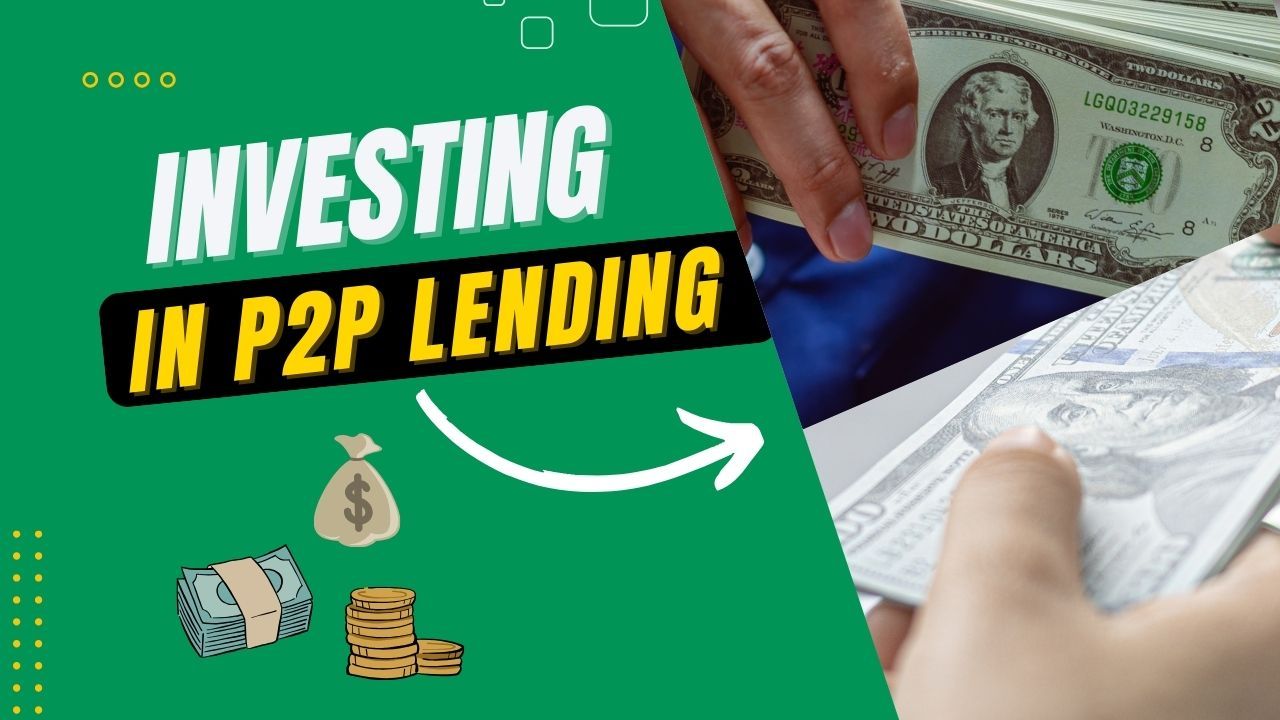The Pros And Cons Of Investing In Peer-To-Peer Lending

Futureincomes.site Hi Today I want to explore the unique side of Investment. Notes About Investment The Pros And Cons Of Investing In PeerToPeer Lending Get full insight by reading until the end.
Overview of Peer-to-Peer Lending
When P2P lending is mentioned, it refers to peer-to-peer lending which basically focuses on the needs of “peers” or individuals who want to borrow money from other individuals. It takes place through online platforms and does not require any third party institutions like traditional banks in the process which makes funding accessible in a short time frame and also with lower rates.
Within P2P lending it allows for a simplified and less time-consuming alternative to the traditional channels of borrowing from banks. Also, through P2P, people can invest their funds into diverse borrowers which advances their portfolio.
Novelty disrupts usual ‘scenes’ and the P2P lending management observes that this novelty is featuring prospective borrowers who maybe are shunned by traditional institutions because of the degree risk involved and also because returning of the funds with interest is almost always guaranteed for the lenders.
Step-by-step Guide To Peer To Peer Lending
In this mode of investment, there is minimal need for organizations. People can lend money to each other directly through a web-based platform which is termed as P2P lending (Peer to Peer lending) and borrow online from willing lenders.
The process of applying for a loan as well as lending money occurs online in P2P lending companies. Borrowers & lenders use multiple platforms for lending as well as checking their credit worthiness before the transaction. P2P companies act as facilitators of loans by bridging the gap between borrowers and lenders. The establishment of such companies allowed streamlining a conventional process of informal lending.
P2P lending has its advantages with borrowers having a more favorable chance of getting funds and lenders getting a higher investment return. All the same, such participants should be aware of the risks involved, including loan defaults and absence of deposit insurance.
Emergence of Peer to Peer lending
Over the past few years, there has been an interesting trend in the financial world-these are peer to peer lending. P2P lending combines the ‘borrow’ and ‘lend’ functions into one practice that helps users avoid traditional banking channels.
P2P lending enables body lending and borrowing without the interference of the go-betweens because one can a lender meets the borrower directly. This makes lending easier as intermediaries are not involved and allows borrowers to get lower interest rates while investors get higher returns.
P2P lending companies make use of the Internet to bring together borrowers and lenders with the entire process being safe and transparent. This new system has become popular due to its ease of access, short duration and the fact that it is flexible.
Because of the increasing adoption of the P2P lending model, the traditional lenders are being threatened by competition. The strategies embraced in lending by the peer to peer lenders indicate that the world is undergoing a transition towards more decentralised models whereby individuals are empowered and the access to finance is more inclusive.
The Perks of Peer to Peer Lending
Of course! Peer to peer lending incorporates giving out loans and seeking them out without the traditional dependence on banks or monopolistic financial institutions. This way has many advantages as described below.
First of all, this creates chances for people to secure financing which may have been otherwise impossible through the conventional institutions. In addition, engaging in peer to peer lending always provides the borrows with lower interest rates and the lenders with higher returns as compared to other banking products.
Also, it enhances the scope of financial inclusion by enabling access to capital to disadvantaged or marginalized people. In addition, the online sites used in the process of peer to peer lending also makes everything easy and effective at the same time.
For the most part, peer-to-peer lending is a great option for borrowers and lenders trying to find an alternate finance solution that works for them especially in this era of capital creativity.
The Potential Returns of Investing in Peer to Peer Lending
Peer to peer lending has become renowned to be embraced by individuals looking for investment opportunities that are capable of giving back great returns. This is due to many factors. One being this type of investment strategy allows you to lend out money directly to people without having to go through banks.
A major benefit of peer to peer lending is it allows one to earn more on their investment as compared to normal investment such as stocks or bonds as the earnings would be made through lending to the general public and earning high rates on the funds used.
Moreover, P2P lending websites let their investors place more than one loan when funding their projects, therefore building their portfolios. Such actions minimize losses and help to arbitrate against defaults.
It's very important to acknowledge that peer to peer lending has some risks that are quite distinctively peculiar to them. Default probability, the borrower’s credit score, and the platform’s reliability must be assessed when a decision to invest is made.
Not to say however that peer-to-peer lending is not an attractive option for those who are looking for an alternative mode of investment to make greater returns.
The Diversification Advantage Of Peer-To-Peer Lending
What is an important advantage of the P2P lending model? The answer is: the possibility of diversification. Thanks to this strategy, borrowers can spread their risk over as many loans as possible and, hence, limit the damage case they select to go into default Ample diversification is available to the investors so that the risk of total loss of their investment is greatly reduced.
With P2P lending platforms, investors can easily access a sizeable number of potential borrowers enabling them to spread their investments across various sectors, loan categories, and credit ratings of borrowers. Such diversity can, in turn, help the investors get a more consistent and less volatile return on their investment on the average.
In addition, investors can benefit from several tools and data analytics on peer to peer lending platforms and especialite on informed decisions with their investment. Hence, investors are able to create a mixed portfolio which matches their investment’s risk and their investment objectives.
In essence, diversification is an important strategy in peer-to-peer lending that allows investors to increase their returns and reduce their exposure to different risk factors.
Assessing Double-Edged Swords Of Peer-To-Peer Lending
Peer-to-peer lending, as a new finance alternative, has become increasingly accepted as an appealing investment opportunity. But it is essential to assess the risks before anything else.
The risks involved are several, the foremost being the risk of default by borrowers. Borrowers can consider peer to peer sites, however, these borrowers do not have because of the mandate to place assets with loan recipients. Therefore, the lenders are open to the risks of impairing their capital outlay.
Moreover owing to the fact that they are operating within an unregulated and ungoverned structure, the investors take risks of being cheated. There is also an experience of liquidity risks because these loans in P2P format are lock in styled and are not readily marketable for sale.
It is, therefore, also necessary for the investors to do proper due diligence before partaking in P2P lending. However, once these risks are taken into consideration, the investors have little to worry about in terms of making bad investments.
The Impact of Default Rates on the Operation of Peer-to-Peer Lending Services
When looking at peer-to-peer lending, it is fair to assert that there are factors that are taken advantage of. It goes without saying that, amongst those, default rates are the most essential. They have an excellent influence not only of borrowers but also of lenders in equal measure. The more the levels of default increases, the greater the financial exposure and loss likelihood for lenders. This is largely a contributing factor to the reduced confidence investors have.
This will be able to bring a restriction in the amount of capital resources available to borrowers, causing a credit squeeze. Additionally, high default ratios can contribute towards borrowers paying higher manageable rates resulting in failure to compete with alternate sources of lending such as the conventional methods.
In the same breath, due to high default ratios, lenders could also increase their restrictions on eligibility which further exacerbates the challenges faced in borrowing. For this reason, it is necessary for P2P lending platforms to actively control and reduce default rates through risk evaluation, education of borrowers and collection to enable the health and sustainability of a lending ecosystem.
Legal Issues Impacting Peer to Peer Lending Providers
In the past few years, p2p lending has grown to be a popular investment option among alternative investments A different track is that these investors must be cautious of the legal issues regarding lending of this sort.
A good example is proper licensing and registration as not every jurisdiction has the same regulations. There is also the issue whereby investors must be aware of risks posed which include high default rates and lack of protection for investors.
Peer to peer investors must be able to understand and also adhere to the relevant regulations so that they can advance towards making P2P an efficient and rewarding investment vehicle.
Investigation on Peer-to-Peer Lending Loan Selection Process
Investigation on Peer-to-Peer Lending Loan Selection Process must be conducted to both the borrowers and lenders. In the present age, P2P lending is gaining traction as one of the substitutes to the traditional form of banking financing.
Nonetheless, the loan selection procedure can also be seen as cumbersome, and its efficiency should be measured at all times. One of the dimensions which must be taken into account when assessing the loan selection process is the practice of P2P platforms to set up lending criteria in order to determine the likelihood of serous default on behalf of the borrowers.
Credit scoring, income verification and employment history, debt to income verification among other factors are some of the common determinants utilized. Understanding the role and influence of these factors on the propensity of default and loan repayment can help determine the selection process’s usefulness.
A third aspect of the evaluation is locating the extent of the loan classes within a p2p lending platform. There are other additional advantage of spreading risk purchase several types of loans. The investigation on the extent of scope and the relationship between default rates may enable the lenders understand how risk is managed on the platform.
In addition, the need for application in practice of the evidence on loan selection processes requires thorough sampling. Lenders are supposed to be able to see certain aspects of the borrowers such as their profiles, provision of the loans and the default rate. High transparency may be able to avail the needed information to the lenders and this may enable the lenders make good investment decisions.
We should also investigate the technology infrastructure of the P2P lending platform in question. The use of algorithms for the matching of loans, reliable data protection, and working payment systems smoothen the process of selection of loan.
Examining such factors guarantees that the platform has enough capacity to accommodate the large number of loans and facilitate the process of lending and borrowing with ease. To sum up, when Borrowers and suppliers of funds participate in a Peer to Peer lending process, the evaluation of the process of loan selection requires examination of the variables employed in determining the firm’s credit worthiness, practices in diversification, transparency and the technology used.
The processes of evaluation enable the borrowers and lenders to take informed steps and appreciate the complexities and the advantages that are brought about by P2P lending.
The Role of Due Diligence in Peer-to-Peer Lending Investments
On the other hand, due diligence is an important activity to be performed when making investments in the peer-to-peer (P2P) lending. Investors in P2P lending systems do not require traditional finance intermediaries as borrowers and lenders are brought together directly.
However, while this creates opportunities for borrowers as well as lenders, it also poses risks. It is hardly possible to avoid risks when participating in P2P lending without conducting due diligence. One important aspect of due diligence is the analysis of the creditworthiness of the potential borrower.
The credit score of the borrower, income generation abilities, and debt to income ratio, should be evaluated by the lenders. Information of this nature assists to assess the possibility of being paid back, as well as the profit that can be gained from that investment. It is also critical that the reputation and performance record of the platform be of good standing.
Platforms with these features are expected to have effective procedures for systems development, non-default loans and good reputation. Many investors however fail to understand the basic requirements of the loan to be given to them.
There is more than just understanding the loan amount that has to be paid back to the lender. This will include the review of the agreement, cost of borrowing, other levies, time of the credit and its repayment. Terms of a lending contract are essential since they deal with the lender’s parameters of preferences and their risk level in their investment options.
Another strategy is diversification where, in the case of P2P lending, the employing strategy is that of risk management. This will lessen the default risks by delaying and extending the repayments. Capital loss and overall risk of the debt are decreased by diversification.
Last but not the least, knowledge on changes and improvement of policies in this case regulatory policies is important. This area of study is developing and changes may occur in the future without notice. The main points are that lenders are mandated to be updated in order to benefit from the investments.
To summarize, performing such an assessment is vital if an investment in P2P lending is being considered. Steps such as evaluating the creditworthiness of the borrower, looking into the platform’s track record, comprehending the terms of the loans, pooling together many loans, and further extending one’s understanding of the area are all important to ensure that the P2P lending investment is both sound and successful.
Tax Treatment of Income Earned from Peer-to-Peer Lending
Investing in peer – to – peer has complemented the natural growth in investment in recent years. However, these lending opportunities are not without problems, especially concerning how the income generated will be taxed.
However, in most jurisdictions such as the United States, this income is subject to taxation. Revenue earned through peer to peer lending platforms is usually subjected to taxes as ordinary income and must be declared in one’s personal tax returns.
Unfortunatly there are also some restrictions placed on them as self employed individuals or businesses which may result to using a tax payer id which will result in incomoverable taxes. Additionally some countries impose restrictions on lenders or peer to peer investors by requiring them to register as a financial institutuion or acquire a license resulting to additional tax liabilities.
With that in mind, always talk to an accountant about deducting local taxes and reaping other tax advantages.
Grasping the liquidity of peer-to-peer lending investments.
Peer-to-peer lending investments are made through online platforms that connect the money with the borrowers in need of it. It is very important for investors to grasp the liquidity of such investments. According to the world bank, liquidity is the degree to which an asset or security can be quickly bought or sold without affecting the asset's price.
Now in p2p lending platforms, liquidity is an important factor because it determines whether an investor can obtain their funds as and when required. However, p2p lending has a component which can be highly illiquid unlike shares or bonds which transact orders on an exchange.
Most platforms do provide a secondary market where the investors are able to offload the loans they have to another investor, but this process might not be instantaneous. There are also some platforms that allow early bailed out investors to leave but there are usually some form of fees or limits on the investor.
So lags in the liquidity of Peer to Peer Lending investment allocations should be given sufficient attention especially as some investors center their portfolios heavily based on peer to peer lending investments. This is also crucial for investors to understand the challenges they may face in pursuing the investments in order to effectively control their goals.
Thank you for listening to the pros and cons of investing in peertopeer lending in investment until the end Thank you for your attention and time you have given, never give up and prioritize health. Please share it with your colleagues. don't forget to check other interesting articles. Thank you.

